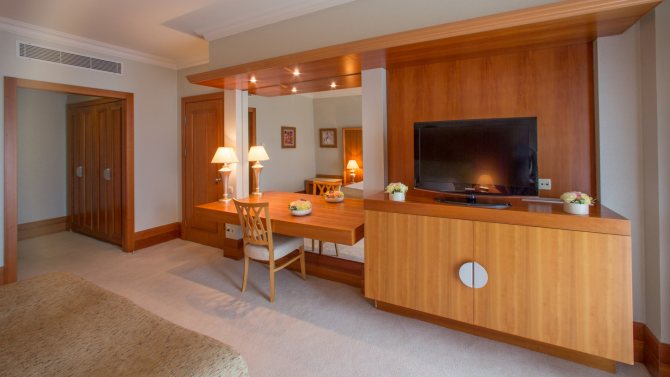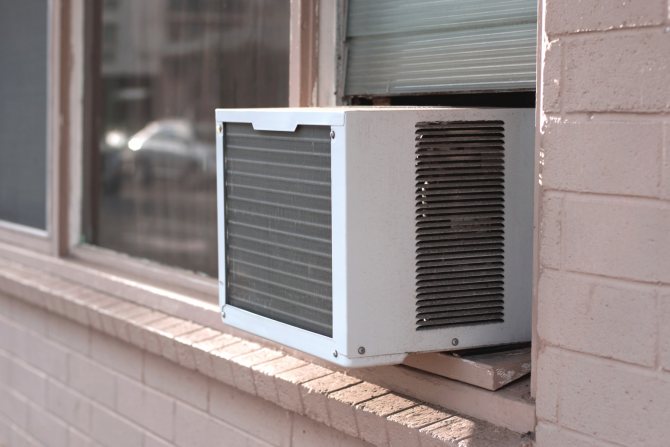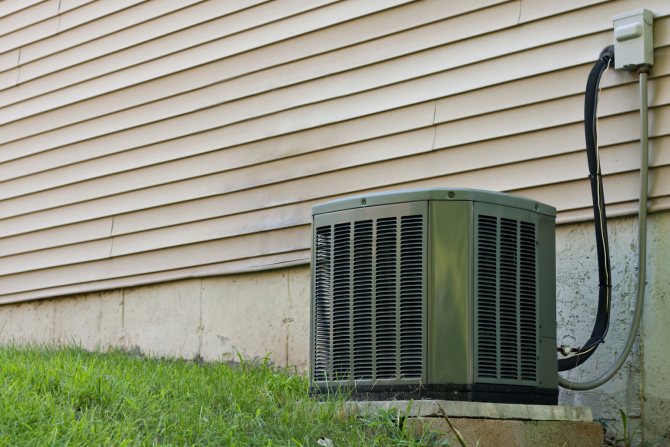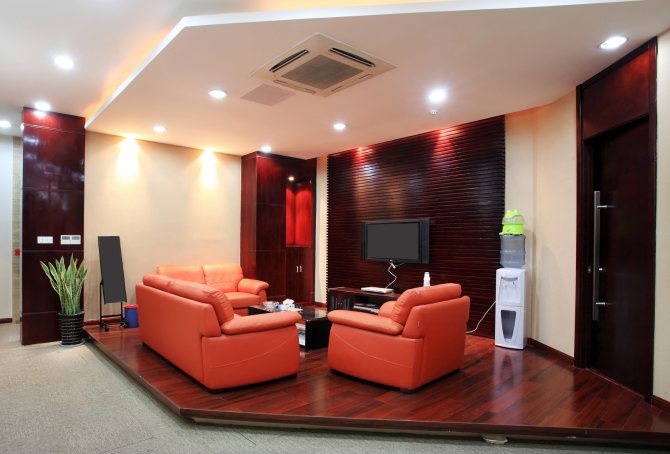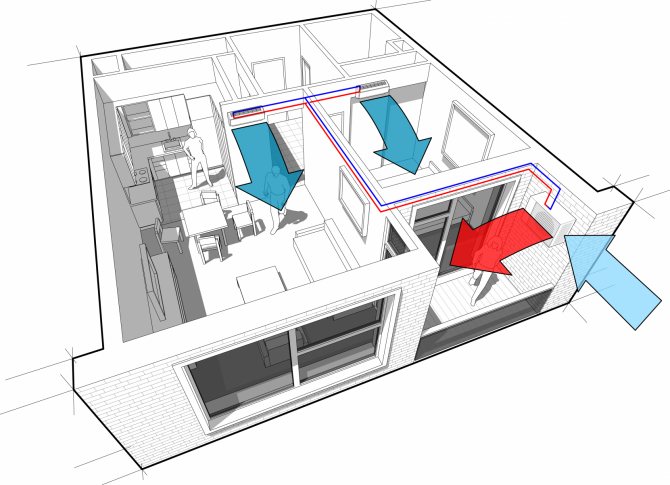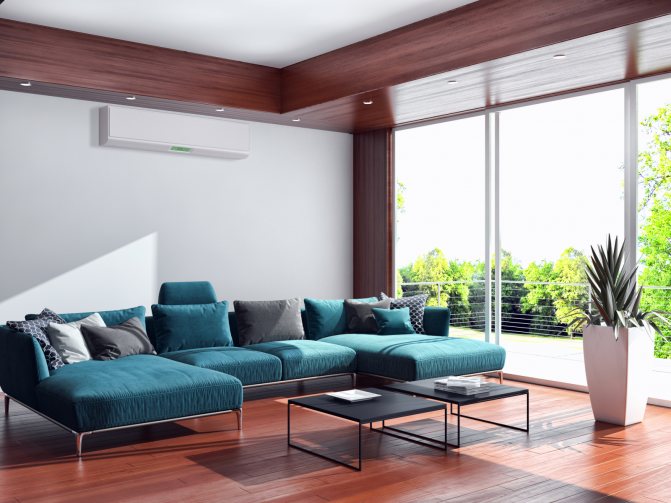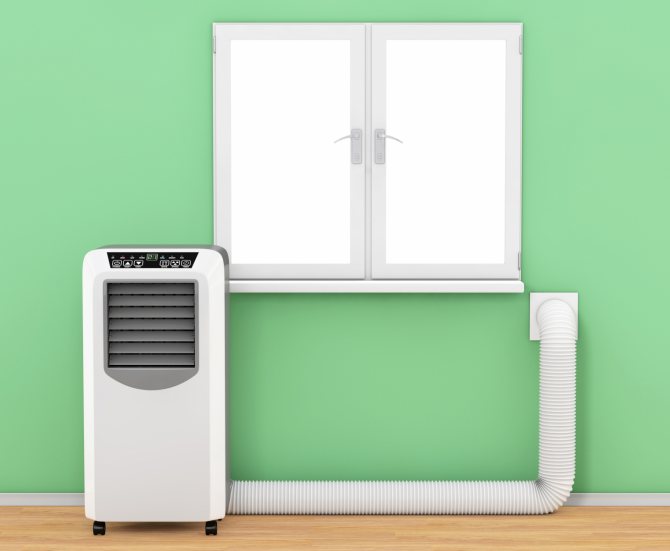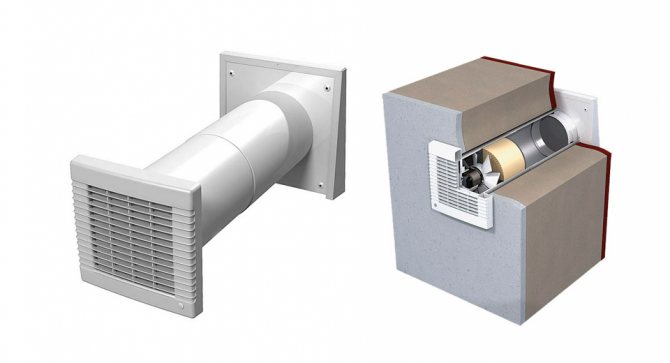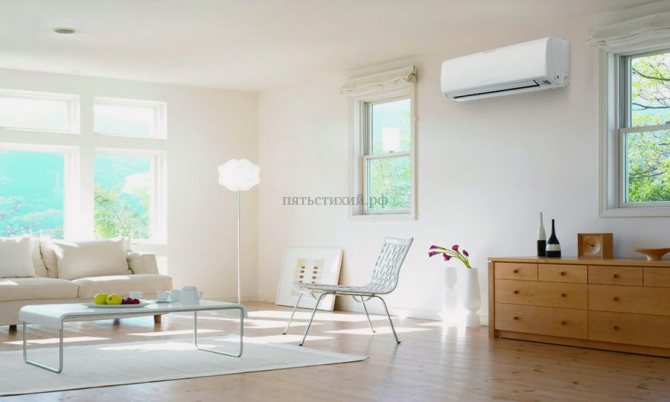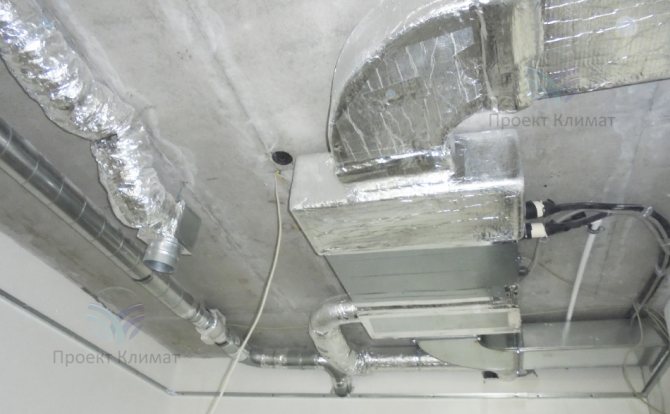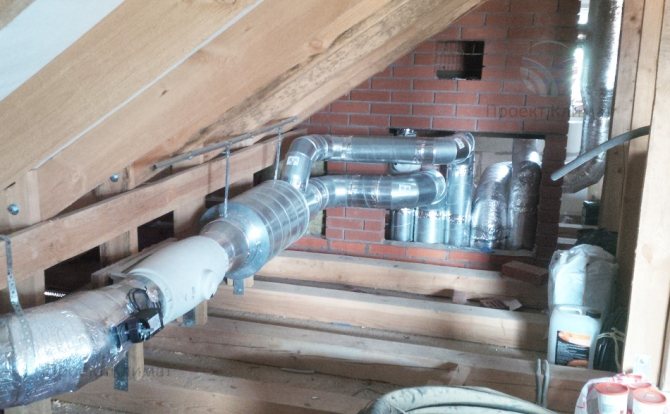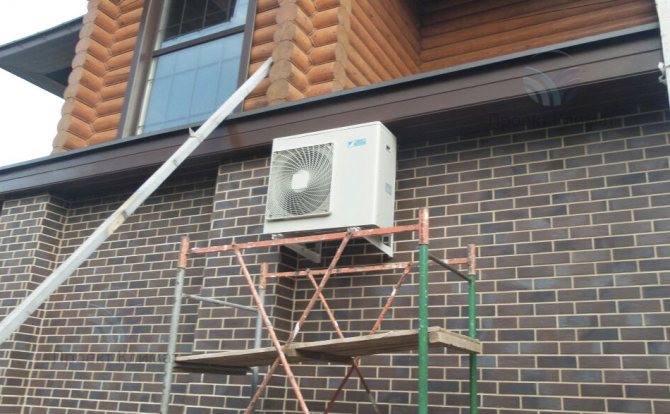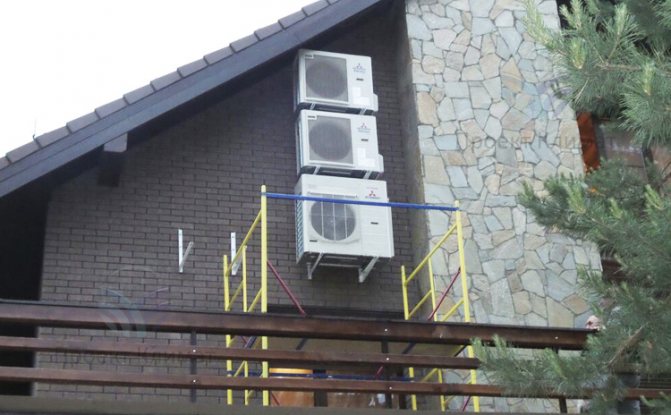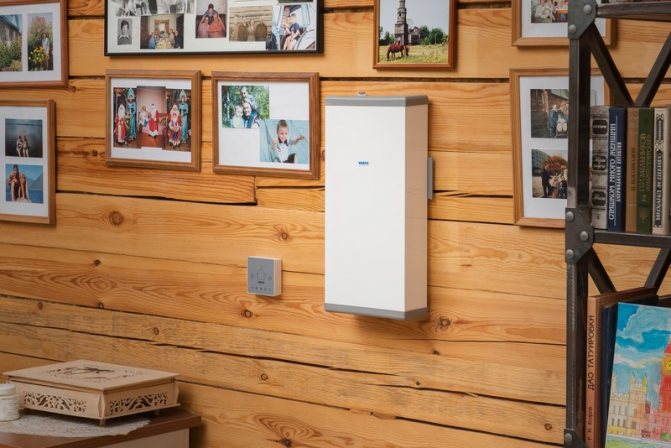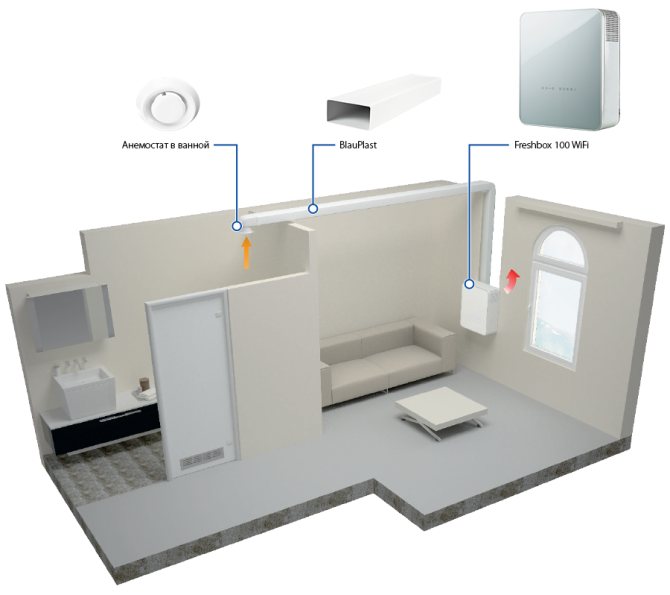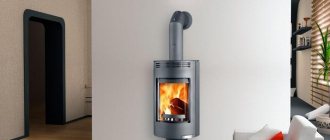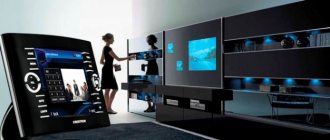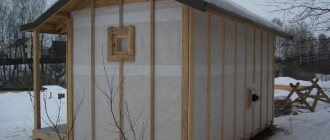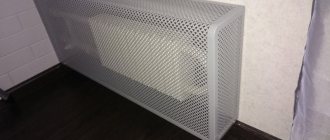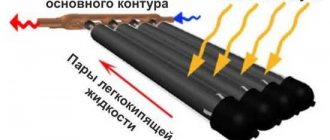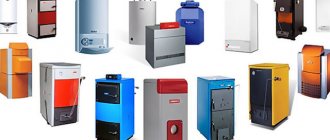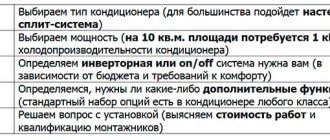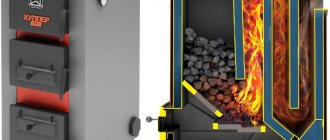Greetings to everyone on the Kondicionershik website! Today I will tell you how to choose an air conditioner for your home and where it is better to install it.
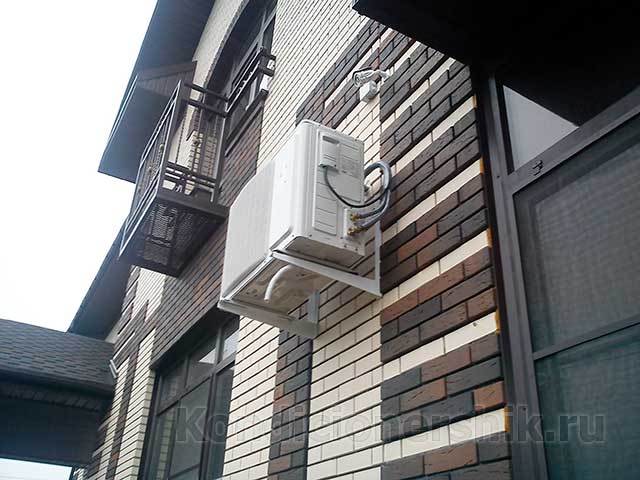
The air conditioners on the market not only cool the air, but also heat, clean and dry to the required parameters. It is difficult for an ordinary buyer to make a choice. Therefore, I recommend that you first decide on a budget, and then choose a model. You will need to know more about the brand and the characteristics you want.
The most important criteria are device reliability and performance. This year, models with ionizers, self-cleaning systems and self-diagnostics are popular. Manufacturers do not stand still, and every year they release new improved models. To understand all this, I have prepared only the most important information.
Type of air conditioning system of the cottage
The most popular types of climatic equipment are:
- wall split systems, including multisplits;
- duct air conditioners;
- multi-zone systems.
Wall mounts are an inexpensive way to air condition a cottage.
But for a multi-room house, it is not the most convenient. After all, each room will have to install its own air conditioner.
Multisplits - there are several indoor units for one outdoor unit. That is, you can get by with one air conditioner for a medium-sized cottage. The equipment works quietly, the main noise is from the outdoor unit, which is mounted outside. The air temperature in each room can be set differently. Up to 9 indoor units can be connected to one outdoor unit.
Installation of a multi split air conditioning system in the house.
In addition to the use of split systems, multi split systems are perfectly used for air conditioning and heating in cottages and country houses. Nowadays, this type of application of air conditioners is very popular. The main difference from the standard split system is that one outdoor unit works for several indoor units.
The outdoor unit of a modern multi-split system is equipped with a high-performance compressor, an automatic control system and a powerful heat exchanger. The main feature and, among other things, the advantage of such air conditioning is the ability to connect different types of indoor units to an external unit: traditional wall, cassette, floor, duct, ceiling. This feature is very useful when the rooms and premises of the house have different designs and design features.
The use of ducts and duct units in the air conditioning of a private house is very similar to a centralized ventilation system and represents the distribution of heated or cooled air from a central duct to a secondary one.
Installation of cassette air conditioners and channel-type systems takes place under false ceilings, or located in the attic of a building. In the same zone, all communications are supplied. The distance between the suspended ceiling and the supporting surface must be at least 200 mm. It is recommended to take this issue into account at the beginning of construction work and carry out the necessary air conditioning channels before the start of repair and finishing work.
It is important to note the availability of channel-type air conditioners on free sale with fresh air from the street. These models can be connected to air conditioning ducts and add 20% fresh air.
But there are also disadvantages when choosing a multi split system for a private house.With a decrease in the number of outdoor units on the facade of a building, the installation of such an air conditioning system in a cottage is often an expensive thing. This is explained by the use of a long length of freon tubes, power supply, insulation, as well as the use of other consumables. Using different models of air conditioning units, inter-unit distances can exceed 20 meters in length and reach 7-10 meters in height differences.
The advantages of installing a multi-split system in a residential building are the convenience of servicing and maintenance of air conditioners, their cleaning. The advantages include comfortable control of room cooling and heating modes, preservation of the style and appearance of the building facade.
In large country houses and mansions with a large area, multi-zone air conditioning systems are used. These are VRF and VRV systems.
See also:
- How to choose an air conditioner for a cottage or a private country house?
Duct air conditioners
Ducted air conditioning systems for cottages are widely used in America and Europe. The indoor unit is built under a false ceiling, ventilation ducts are distributed from it throughout the house.
The advantage of the systems is the ability to mix fresh air from the street, while simultaneously providing ventilation of the premises. The system serves several rooms.
Ducted air conditioning systems in cottages have only one significant disadvantage: additional expenses for broaching ventilation ducts.
Choosing the type of air conditioner
There are several options for air conditioning systems for cottages and private country houses. The most optimal of these is the installation of a multi-zone air conditioning system. The system consists of one or several outdoor units, to each of which, depending on the manufacturer and model, from 2 to 30 indoor units are connected. Outdoor units are placed mainly on the roof or in the backyard and do not affect the overall appearance of the building. A unique feature of multi-zone air conditioners is the ability to simultaneously operate in both heating and cooling modes: this is more than important when the windows of some rooms face the sunny side and others the shady side. Moreover, each indoor unit takes as much cold (or heat) as it needs at the moment to maintain the set temperature, which significantly saves electricity.
The advantage of such equipment is the ability to place indoor units on different floors and at a great distance (up to 160 m) from the outside, with a height difference between them up to 50 meters - this allows you to distribute heated or cooled air to rooms located on different floors. Indoor units can be of various types: wall-mounted, duct, cassette, which allows maximum air conditioning and use for each room its own type of indoor unit of the air conditioner.
The advantage of multi-zone systems is the large length of the line between the outdoor and indoor unit, which allows you to install the indoor unit anywhere in the room and achieve the necessary climatic conditions.
If you need to organize comfortable conditions in one or two rooms of a private country house or cottage, then you can use split-systems. The split system consists of outdoor and indoor units and is the most popular air conditioning system.
The cottage, as a rule, has space for the installation of a split-system, duct type, which is installed under a false ceiling or in the attic. The design of ducted air conditioners allows you to completely preserve the design of the room: the unit is installed behind a suspended or false ceiling, and the distribution of cooled air is carried out through a system of air ducts that are located there; of all the climatic equipment used, only the air grilles are visible on the ceiling. The duct air conditioner has the ability to supply fresh air from the street in the volumes required for full ventilation. There is also the possibility of adding fresh air, ventilation and humidification, which is especially important and necessary in cottages and country houses.In addition, duct-type air conditioners are able to distribute air over a large area of one or more rooms. Competent placement of the indoor units of the duct-type split system will allow replacing the whole network of air conditioners.
The only and important condition necessary for a room to be equipped with an air conditioning system based on a ducted air conditioner is the presence of sufficiently high ceilings in it, which would allow the construction of a so-called suspended ceiling. Behind this false ceiling, it becomes possible to hide all structural parts of the duct air conditioner (valves, valves, air ducts and other elements).
Often for small rooms and premises in country houses, wall split systems are chosen. One of the advantages is the relatively low cost and ease of installation. Recently, there has been an active struggle between manufacturers of wall-mounted split-systems to improve their consumer properties, and first of all, of course, the design of indoor units. New air conditioners with a non-standard design appear on the climatic market: square shape, various colors, with mirrored and replaceable color panels, etc. A significant advantage of the wall-mounted air conditioner is the reduced noise level inside the room, since all units emitting noise (compressor, electric motor and fan) are enclosed in an outdoor unit. This outdoor unit can either be mounted on a building wall or mounted on a balcony.
All modern split systems are equipped with a remote control with which you can set the desired temperature with an accuracy of 1 degree, set a timer to automatically turn on and off the air conditioner at a specified time, adjust the direction of the air flow and much more.
A significant drawback of the split system is the large number of outdoor units, each of which corresponds to one indoor unit. But several outdoor units with fans will not decorate any facade of a country house. What if there is a need to use air conditioners in each room in different modes?
There is only one way out of this situation - the installation of a multi-split system.
A multi-split system differs from a classic split system in that one external condensing unit in this case can simultaneously serve several (from two to six) indoor units. At the same time, the structure and principle of operation of the system remains unchanged - the external and internal units are connected by so-called freon routes, consisting of copper pipes for supplying refrigerant, a drain pipe, as well as power and control cables.
Each indoor unit has its own remote control for selecting individual air conditioner operation settings for each room.
Indoor units of a multi-split system can be of the same type (wall, floor, etc.) or combined depending on the technical characteristics of the room, interior design considerations. The blocks may also differ in technical characteristics, depending on what are the requirements for the required temperature regime for a given room.
The multi-split system not only simplifies the control of the entire air conditioning system, but also allows almost half the energy consumption, thanks to the outdoor unit compressors with inverter control.
Multi-zone conditioners
Optimal comfort in a large country house will be provided by multi-zone air conditioners. The biggest advantage of this air conditioning method in cottages is the ability to lay long communications between the modules.Therefore, outdoor units can be installed in any convenient place.
Several dozen indoor units are connected to one outdoor unit, which can be of different types (wall-mounted, cassette). At the same time, they can simultaneously warm some rooms and cool others, which is not possible with other air conditioning systems.
Temperature drops in the premises are only 0.5 degrees, which is impossible to provide with other types of climatic technology.
Multi-zone systems simultaneously heat, condition and ventilate the premises. However, they consume less electricity than other systems of similar power.
Column air conditioner
This type of air conditioner is very often used in rooms where a high degree of coolness is required and there are absolutely no aesthetic standards. It is best used in warehouses or manufacturing. It is better not to use this type of units in the living quarters of the house. It can be located in any other technical or utility room in the house.
Column air conditioner
VFR system
Such climate technology not too long ago came to the modern market, but, in spite of this, it has already won the recognition of users. It has the ability to use several outdoor and indoor units. Indoor units can perform air purification, cooling and heating functions.
All blocks are connected by special pipes through which freon circulates. The very operation of such a system is controlled by built-in automation. A supply unit for ventilation may also be included in the kit.
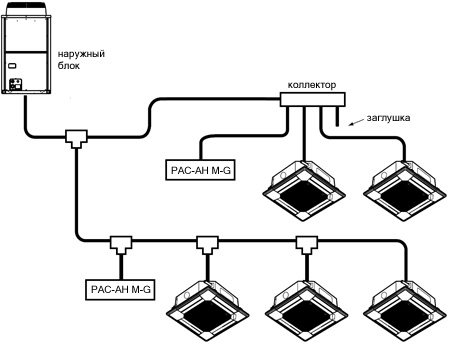

scheme of operation and installation of the VFR air conditioning system
VFR systems are a new direction in the creation of air conditioning in the house. The length of pipes that connect indoor and outdoor units can be up to 100 m, which allows the unit to be installed far from the outside.
Advice. The outdoor unit of such a system can be installed in the basement or on the roof, and the appearance of the building will not be spoiled.
Systems allow the use of 30-32 indoor and 3-4 outdoor units
at the same time.
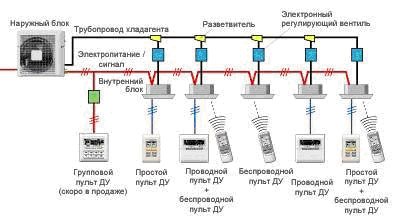

Inverter types of air conditioning systems
In simple terms, inverter models of air conditioners can regulate the operation of the compressor motor and create an optimal temperature regime in the room. It is the speed of rotation of the engine that makes it possible to effectively cool or heat the air masses.
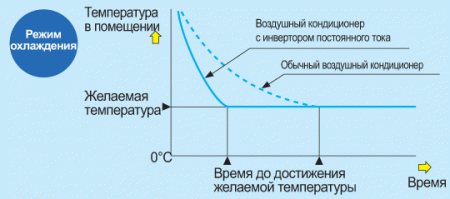

Benefits of inverter systems:
- multifunctionality;
- quick response to changes in functions;
- automatic creation of the optimal temperature regime;
- ventilation of the room with fresh air;
- ionization of air masses;
- low level of consumption of electrical energy.
The functions and properties of such air conditioning models are orders of magnitude higher than standard split systems. We can say that they are also split systems, but with great capabilities and functions. Compressors in inverter models are standard, which means that the amount of electricity consumed will be low, which will make it possible to constantly use such an air conditioning system. In the event of a breakdown, it is better to contact a professional.
It is possible to use an inverter-type air conditioner in winter. Only there is a certain temperature maximum, which will not allow the equipment to be operated at -10, -15 degrees of frost. The systems have adjustable blades, which makes it possible to direct the air flows in the desired direction.
Advice. Inverter air conditioners are best mounted in any corner. Thus, the flow of air masses will be carried out in a circle.
Inverter air conditioning systems always have a beneficial effect on the indoor climate. Today there are different types of inverter split systems. They make it possible to connect several internal units to one external unit.As a rule, the maximum number of such connections does not exceed 5 pieces of indoor units.
Central air conditioning system of the "chiller - fan coil units - individual heating point" type
Central air conditioning systems are used to heat a cottage at any outdoor temperature, as well as to cool, heat and clean the air from dust. In principle, it is possible to combine such systems with supply ventilation units, however, in practice, it is customary to organize air exchange in cottage rooms using supply and exhaust systems independent of the air conditioning system.
The fencoil system has a number of advantages of VRV systems, as well as very low inertia and configuration flexibility. It can be used to condition the air in a building with any number of rooms. In air-conditioned rooms, special devices are installed - fan coils, similar to the internal blocks of split systems. For cottages, floor-standing fan coils are most suitable, which are easy to place in window niches. There are also open-frame models that are mounted behind decorative wall panels or false ceilings.
Fan coil units with one heat exchanger are units of seasonal operation: in summer they are used to cool the air, and in winter - as heating devices. Fan coil units with two heat exchangers are used in universal systems that can simultaneously cool, heat or simply ventilate various parts of the house. Such a regime is necessary primarily in spring and autumn. For ease of operation, fan coils are equipped with special remote controls and an automation system that allows group control and individual control of each fan coil in automatic or manual mode.
Fancoil units are connected to cold and hot water sources or to suitably prepared non-freezing glycol. For domestic purposes, water or glycol mixture is cooled by an air-cooled chiller of a condensing unit with a capacity of 2 to 50 kW. The most modern chillers are equipped with scroll and screw compressors and have low starting currents (which is important for poor cottage wiring), as well as high efficiency. Similar to the outdoor unit of VRV systems, the chiller is installed on the roof, on the wall, in the garden or in a utility room located at any distance from the house. In regions where the outdoor air temperature never drops below -15 ° C, a chiller with heat pump mode can function as an individual heating point. This will greatly simplify the design of the fencoil system.
In the Moscow region and in other areas of active cottage construction, where the thermometer often drops below 30 ° C in winter, it is best to use a gas boiler as a source of hot water or glycol mixture, which is several times more economical than an electric chiller with a heat pump. Another source of heat is hot water from the central heating system. True, due to poor quality and high temperature, it is suitable only for indirect heating of the coolant supplied to the fencoil system.
Installation and commissioning of the system "chiller - fan coil units - individual heating point" will cost the customer approximately 25-30% of the cost of the equipment, and the simplified version - 20-25%.
Systems with variable volume and temperature of the air supplied to the premises
The specified system is able to maintain all the main parameters of the microclimate of the premises - temperature, humidity, purity and air mobility - within the optimum values. This becomes possible due to the supply of air of a certain temperature in metered quantities to the conditioned zones.The equipment in many respects repeats the equipment of traditional air central air conditioning systems. All air processing, including heating, cooling, as well as centralized cleaning, humidification and ionization, is carried out by a roof-top air conditioner or a modular central air conditioner. Roof-top with indirect gas heating of the air flow is installed on the roof of the cottage or on the ground, next to the house, and with the help of special equipment is connected to the gas main and the power grid. The central air conditioner of modular type, which is a set of various air handling devices, is located in a special technical room. Sources of heat and cold supply for it are usually an individual heating point (boiler) and a water-cooling machine - a chiller.
The prepared air is supplied to the rooms through a network of air ducts, which are mounted above the suspended ceiling. The duct mouths are closed by ceiling linear diffusers or specially designed grilles that distribute the air extremely evenly throughout the room.
In order for air of a strictly defined temperature to enter each room, a thermostat is set in all air-conditioned zones. At the same time, several air-conditioned zones can be allocated in one large-sized room, or a number of small rooms can be considered as one zone.
The microprocessor unit controls the operation of the air conditioner (in cooling, heating or ventilation mode) and the sequence of supplying conditioned air to the premises according to the summarized data of all thermostats. As a result, the zone control valves installed in the ventilation ducts directly in front of the diffusers allow the required volumes of prepared air to pass through. The system includes gas analyzers, humidity sensors and other monitoring equipment.
Installation and commissioning of a system with a variable volume and temperature of the air supplied to the premises at the proper level can only be performed by highly qualified specialists. The cost of these works can be up to 35% of the cost of a set of equipment.
Types of ventilation for cottages
Natural ventilation saves electricity, but it has some drawbacks. To ensure full air exchange, it is necessary to prepare an outflow system in the form of ventilation ducts. The thrust level is achieved only by the corresponding length of these channels, therefore the option is suitable for two-storey buildings and more.
For single-storey houses, it is recommended to choose a combined type of ventilation. In this case, fans are installed at the inlet of the mines - the air flow remains natural, and the exhaust works with the help of fans. For a uniform inflow and outflow of air masses, it is important to correctly select the power of the fans relative to the area of the premises.
Forced ventilation is used if the previous options are ineffective. Filters, fans, valves, coolers and heaters are used to equip the duct network system. The system can work automatically according to preset parameters.
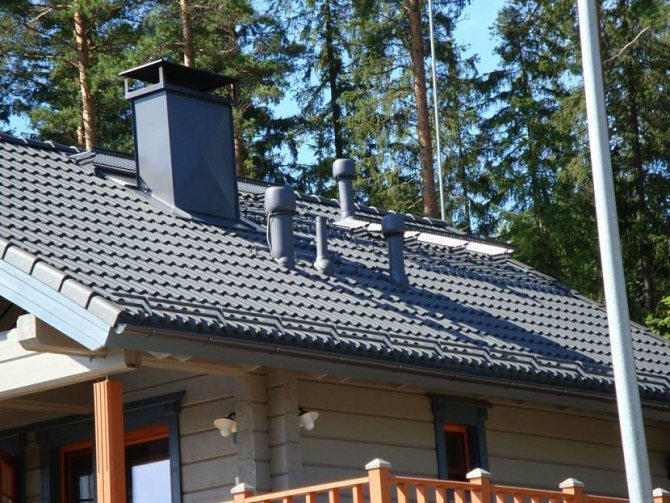

Conclusions of ventilation ducts Source taurus-sk.ru
Split systems and multisplits
This air conditioning system is almost the same as air conditioners. There are also two blocks: internal and external. Noisy condenser and fan mounted on an external wall. The indoor unit contains filters and fans of the internal system. Such a block can be hung on any wall or ceiling.
The indoor and outdoor units are connected to each other by pipes for supplying freon, which transfers heat from the unit inside the room to the outside. The radiator of the indoor unit is cooled by a fan, which prevents such a unit from overheating.
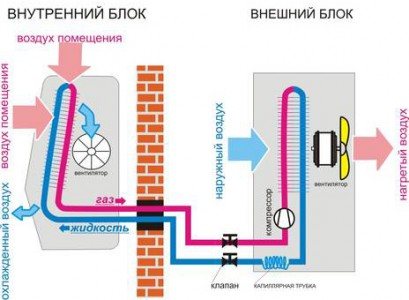

Today split systems are equipped with a remote control. It allows you to set the following modes:
- cooling,
- heating,
- ventilation,
- drying,
- night mode.
It is possible with the help of an automatic system to determine the temperature regime in the room and select the optimal operation of the split system. There is also a choice of fan operation. The equipment is equipped with a timer that allows you to turn it on and off at the right time. The curtains are also adjustable, and this makes it possible to direct the air masses in the desired direction.
Multisplit allows you to use several indoor units with one external unit. Each such device has its own separate remote control. Systems of this type are already equipped with special air filters. There are duct and wall multisystems, like air conditioners, only multisplits have great functionality and practicality.
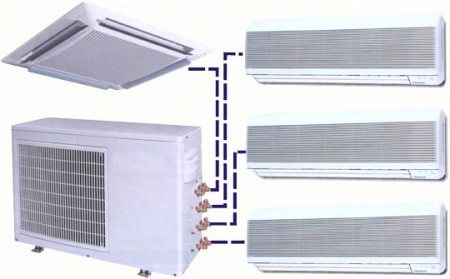

Split systems of cassette type
Such systems are installed under false ceilings. They can direct air only in three directions, and cooled air enters the room through the lower part of the indoor unit. Cassette split systems are powerful and distribute air masses evenly in the room.
The main advantages of such a unit include the fact that it is practically invisible and will not violate any design incarnations. Do not forget about saving electricity, since you can use only one unit of this type indoors and it will be enough, of course, if the space itself is not too large. It is very convenient to use such an air conditioning system in the bedroom. It is practically silent and distinguished by its functionality.
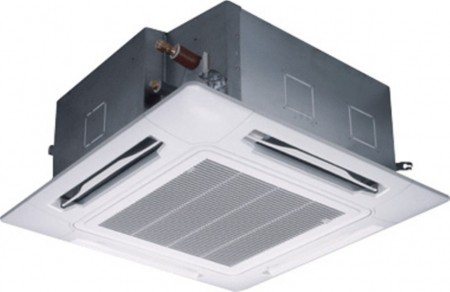

Types of air conditioners
There are two types of air conditioning systems at home, depending on the type of fasteners and air supply: wall and duct.
Duct air conditioners
Today, a split-system of a channel type with all adapters and protective grilles for an ordinary user is several times more expensive than a standard split-system with an internal block. This is because the duct type of air conditioning of the room involves installation in ceiling coverings, and only warm air can be removed. With the help of adapters, air masses are extracted and discharged through the exhaust ducts. This is the reason for the high cost of duct air conditioners.
Adapters are made separately for each model of such an air conditioner, and there may be a problem with finding this part in the event of a breakdown. To prevent this from happening, you need to first think about air mass filters that can be installed in the room. There are plenty of them on the market at the moment. There are mobile units that are not only capable of filtering air masses, but also humidifying, dehumidifying and ionizing the air.
It happens that a breakdown of the duct air conditioner engine itself may occur. Since it is fixed to the ceiling, you will have to disassemble the ceiling covering to dismantle the air conditioning system.
Advice. In order not to damage the appearance of the room, it is best to install ducted air conditioners on the ceiling, the covering of which consists of separate elements that can be dismantled as needed (slatted ceiling, tiled coverings, and so on).
It is possible to make control of such an air conditioning system not only from a mobile remote control, but also from a remote control that is installed on the wall. To do this, you need to find a convenient place and conduct the necessary communications (electricity) there. It is worth paying great attention to the installation of an infrared sensor, which will ensure the receipt of signals from the control panel. The system is quite complex, but multifunctional and practical.
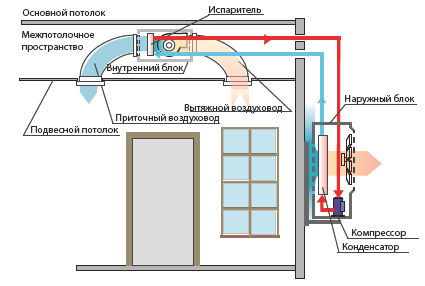

Implementation of the operation of a duct air conditioner
In a ducted air conditioning system, you need to select and install the grates correctly. The wrong choice can affect the operation of the air conditioner, and condensation can simply drip from the blades of the system inside the room. All this is only a human factor, and it is for this reason that it is better to entrust the installation and selection of air conditioning systems at home to professionals.
Along with the great advantages of channel type air conditioners, there are a number of disadvantages. This type of system is very difficult to clean and maintain regularly. If you do not constantly take such measures to prevent the formation of plaque on the blades or on the engine, then over time the system may simply stop, and repairs will be quite expensive.
Wall mounted air conditioners
There is an alternative to ducted air conditioners - wall units. They are located indoors. The cost of such air conditioning systems at home is quite low and in return the buyer receives a large number of functions. A hose is led out into the street through a special hole, which passes air outside and draws it in from the outside. Such systems are often called inverter systems. Today they can create great competition for conventional split systems.
Installation diagram of wall-mounted air conditioners
Installation of air conditioning systems
After you have chosen the air conditioning system at home, you need to proceed to the steps to install it. It is best to turn to specialists for help, who will not only install, but also configure the system.
Initially, you need to measure the size of the system that will be inside. If this is a split system, then the outdoor unit also needs to be measured. By such actions, the place for the installation of air conditioning systems at home is clearly determined.
The fasteners for mounting outdoor units must be strong. There are special enterprises that manufacture them, and I guarantee strength and durability. Fasteners are represented by metal structures of various sizes. There is an opportunity to choose the best option.
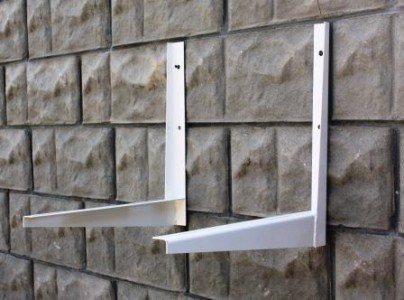

In order for the air conditioning system to work smoothly, you need to correctly install it: prevent bends in the pipes through which the freon is supplied. If you do not follow this rule, then freon can leak out and the operation of the unit will stop.
All brands of modern air conditioners and split systems are almost the same in the installation process, but each system has its own nuances. If you install the outdoor unit of the air conditioner on the terrace, then you need to take into account that condensation from a special tube will constantly drain to the floor. To avoid this, it is best to enlarge the condensate drainage hose itself to the required size and lead it outside the terrace or other room.
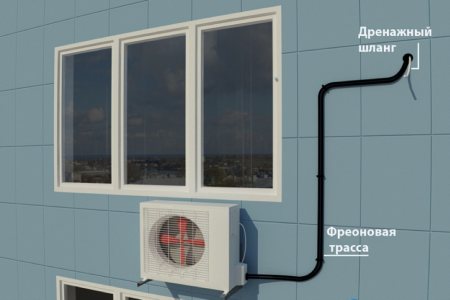

Air conditioning a private house is a very simple process. It consists only in choosing the right system based on your preferences and needs. There are a huge variety of air conditioners and split systems that differ not only in cost, but also in their functionality.
Solutions for preserving the external facade of the house
The use of a multi split system or a multizone system is reasonable if you do not want to spoil the appearance of the facades of your house. The difference between the above air conditioning systems in a private house is that in the case of using a multi-split system, a separate freon line goes from each indoor unit to the outdoor unit, and in the case of a multi-zone system, one common freon line with branches to the indoor unit goes from the outdoor unit. blocks.
When installing duct air conditioners in a house, it must be remembered that for routing air ducts to rooms and installing grilles, it is necessary to allocate space for a false ceiling.In this case, you only see the air distribution grilles. There are also options for cooling the air in a house with one powerful duct air conditioner (for example, one unit per floor), or installing separate indoor units for each room separately (if space permits). The disadvantage of using one powerful unit is that there is no possibility of regulating the temperature in each room separately, since there is only one control panel. The use of several indoor units of the channel type increases the cost of the system itself, but the expediency of using such a combination is a reasonable decision.

